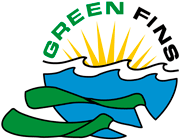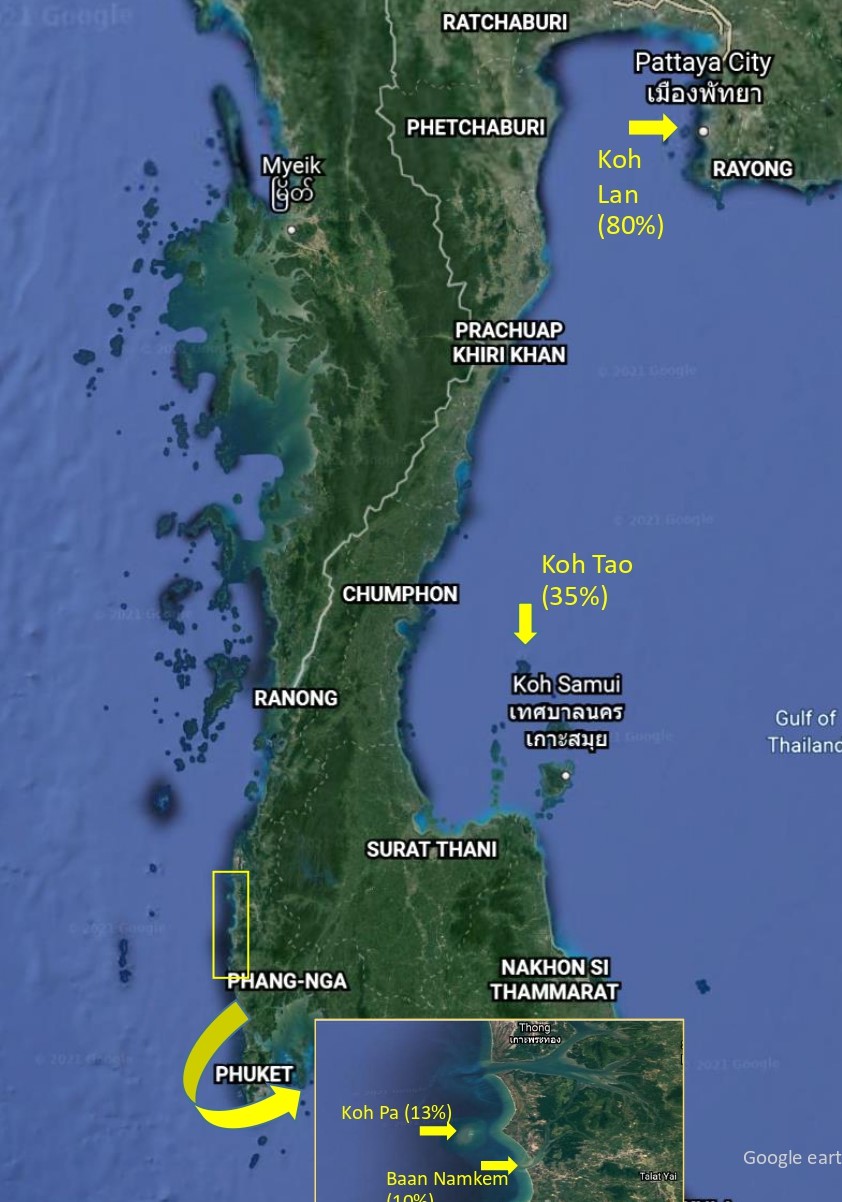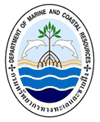GREEN FINS REEF WATCH AT RACHAI YAI
On 22 June 2006, I joined Green Fins dive operator South Siam Divers of Karon, Phuket for a day of Reef Watch coral reef monitoring at Racha Yai Island, south of Phuket.
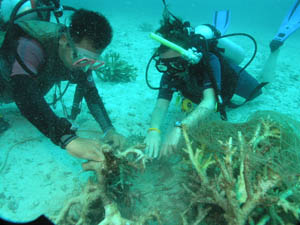 We were to be diving on the East Coast of Racha Yai, and would be sheltered from the West wind as we monitored two of the reefs on this side of the island. The journey from Phuket was not long and it has been several months since my last dive here. This time, I would be joining Khun Niphon Pongsuwan, coral reef biologist at the Phuket Marine Biological Center as well as being Green Fins Project Leader in Thailand, and Khun Keartiyot Phitakchart of South Siam Divers. We would be studying different techniques in estimating the percentage of live and dead coral on a dive.
We were to be diving on the East Coast of Racha Yai, and would be sheltered from the West wind as we monitored two of the reefs on this side of the island. The journey from Phuket was not long and it has been several months since my last dive here. This time, I would be joining Khun Niphon Pongsuwan, coral reef biologist at the Phuket Marine Biological Center as well as being Green Fins Project Leader in Thailand, and Khun Keartiyot Phitakchart of South Siam Divers. We would be studying different techniques in estimating the percentage of live and dead coral on a dive.
K. Niphon would be providing training in the Reef Watch monitoring method being used in the Green Fins Thailand project. The Reef Watch method allows visiting divers to take part in monitoring activities on any dive provided by a Green Fins dive operator. It is a quick and simple way of assessing the health of a coral reef and has been adapted from the original monitoring method developed by Dr. Elizabeth Woods. The focus of this day's diving was for K. Niphon to demonstrate methods of estimating the percentage cover of live and dead coral.
It was a cloudy but clear day. My first impression on descending on the first dive at Staghorn Reef was that the water visibility was good, approximately 15m (50ft). We were over a Patch Reef (or Coral Gardens - areas of reef dotted on the sandy floor) with the main fringing reef in front of us to the South. We were to swim South along the reef, following the shore line at a depth of approximately 10-12m (33-40ft). We set off at a slow pace but were stopped almost immediately by noticing a fishing net caught in the staghorn coral over an area of 2 square metres. We stopped to remove this net, taking care not to damage the delicate coral. This took us 20 minutes of dive time, including taking the net up to the boat before we continued on our dive.
The Reef Watch method gives the diver a choice how to record information on the reef, either by staying in one area or by making a count over the whole of the dive. We chose the latter method which took us over approximately 300m (1000ft) of reef. What to look out for on a dive include how many of a particular fish or invertebrate, as well as signs of damage and an estimate of the live and dead coral cover. There is a neat and easy to use underwater booklet which doubles as a slate - this is marked in pencil and once data has been copied elsewhere can be erased after each use. On the first dive, we were only estimating live and dead coral cover and then comparing our estimations to see if they were similar. The first dive was for K. Keartiyot and myself to learn how K. Niphon estimated the percentage cover of live coral, dead coral, rock and sand/rubble areas. The results were as follows:
| STAGHORN REEF | |
| Live Coral Dead Coral Rock Sand/Rubble TOTAL |
25% 50% 15% 10% 100% |
On the second dive to Lucy Reef at a similar depth and length of swim, both I and K. Keartiyot joined in to compare notes on estimated live coral cover. The results were as follows:
| LUCY REEF | K. Niphon | K. Keartiyot | Anne |
| Live Coral Dead Coral Rock Sand/Rubble |
45% 25% 10% 20% |
51% 28% 12% 9% |
34% 28% 10% 29% |
| TOTAL | 100% | 100% | 100% |
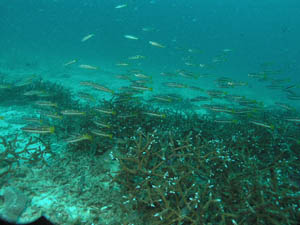 The comparisons showed that similar results are generated using the Green Fins Reef Watch method. It was easy to use and great fun to do. Results can either be sent to K. Niphon via a return box on the boat, by post to the Phuket Marine Biological Center, Cape Panwa, Phuket or directly into a database on the website www.greenfins.org Data is transferred to the Thailand national database which is turn is part of the regional and global coral reef monitoring network of the United Nations. This means that anyone participating in the project now has a chance to help collect information about the state of the world's coral reefs. The more we know about the changes going on, the quicker we can respond to them. Reefs around the world are under threat from several sources from global warming to anchor damage. The Green Fins project is an opportunity for divers to be part of a group of people that want to do what they can to help protect the reefs they enjoy so much. For more information, please contact K. Niphon at info@greenfins.org
The comparisons showed that similar results are generated using the Green Fins Reef Watch method. It was easy to use and great fun to do. Results can either be sent to K. Niphon via a return box on the boat, by post to the Phuket Marine Biological Center, Cape Panwa, Phuket or directly into a database on the website www.greenfins.org Data is transferred to the Thailand national database which is turn is part of the regional and global coral reef monitoring network of the United Nations. This means that anyone participating in the project now has a chance to help collect information about the state of the world's coral reefs. The more we know about the changes going on, the quicker we can respond to them. Reefs around the world are under threat from several sources from global warming to anchor damage. The Green Fins project is an opportunity for divers to be part of a group of people that want to do what they can to help protect the reefs they enjoy so much. For more information, please contact K. Niphon at info@greenfins.org
Anne Miller is Director of the Reef-World Foundation, a UK registered charity that works to inspire and empower people to take care of coral reefs and related ecosystems by using them wisely. The Green Fins project is also being introduced to local Thai fishing communities by both K. Niphon and Reef-World. The Reef-World Foundation has worked with Koh Yao Noi fisherfok for the past 5 years in partnership with REST, Responsible Ecological and Social Tours. For more information, please visit www.reef-world.org
